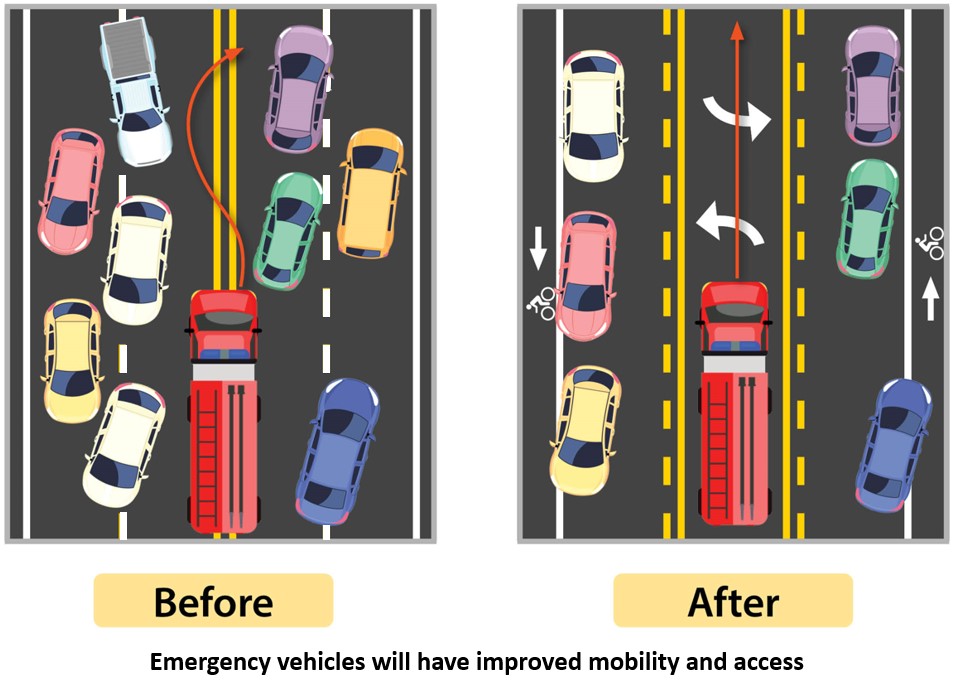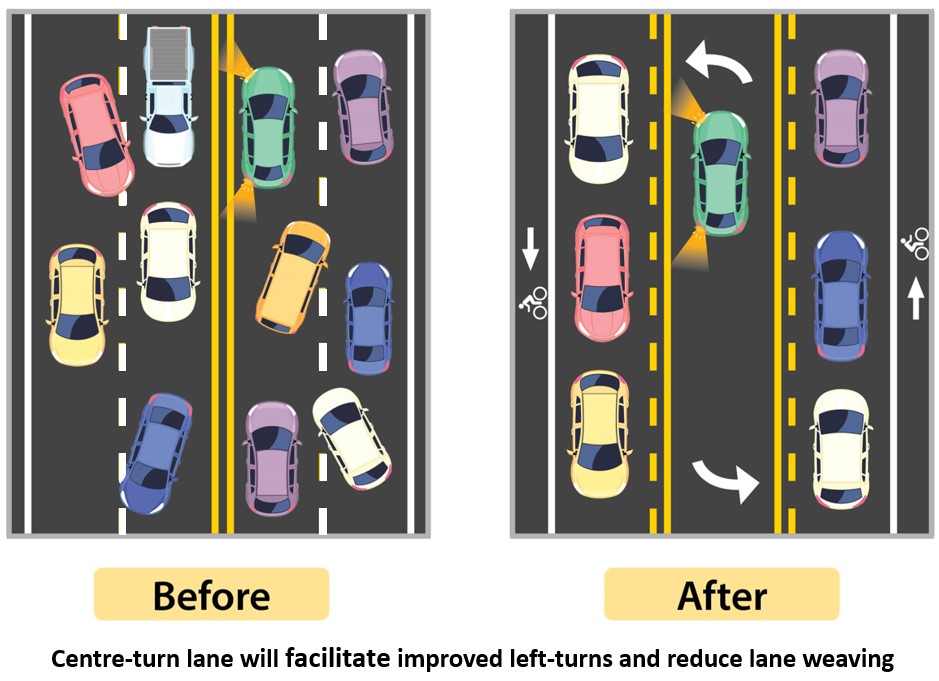FAQs (as of Oct 28, 2025)
Is road safety an issue on this corridor?
The subject portion of Carlton Road has vehicle speeds that are well in excess of the posted speed limit (10-20 km/h over). Also, the City has received ongoing concerns from the community about safety and livability along the corridor, particularly at the Carlton Road and Central Park Drive Intersection. Collisions are high in the area, with a frequency of approximately three (3) collisions per year.
This study is intended to improve safety for all road users through the development and implementation of traffic calming measures. An example being the provision of the new signalized intersection at Carlton Road and Central Park Drive, which will increase safety for all users negotiating the junction and improve traffic flow in this area. The new traffic signals at this intersection are scheduled to be installed and activated by January 2026.
What is the benefit of implementing traffic calming measures?
Safety is the key benefit from introducing traffic calming. Measures implemented encourage slower and more careful driving, leading to fewer and less severe crashes. Neighbourhood residents feel more comfortable, particularly seniors and families with young children, walking or cycling in the area given the reduction in speeding drivers.
Neighbourhood attractiveness can also improve with residents feeling safer to walk or cycle and cars emitting less pollutants due to slower driving (i.e., better air quality), as well as reducing noise pollution from vehicles.
What are some examples of traffic calming measures being considered?
Examples of traffic calming measures include lane narrowing, road diets (reduction in lanes), on-street parking, controlled pedestrian crossings, etc.
How will safety improvements be determined?
In addition to conducting a safety review of the corridor, feedback from public consultation will play a key part in the selection of proposed traffic calming measures. Comments received from the PICs and from input provided on this webpage will be considered. The traffic calming measures will be to the City’s standards and selection based on local concerns, feasibility, costs, and potential benefits.
Will pedestrian crossing opportunities be reviewed as part of the study?
Yes. Pedestrian and cyclist volumes along the corridor will be reviewed to identify new pedestrian crossing opportunities. Generally, road segments adjacent to schools, shopping malls, parking lots and major public transport hubs will have higher levels of pedestrian activities. The Carlton Road and Central Park Drive Intersection will be signalized as part of the study to improve safety for all road users in the area. Moreover, a new pedestrian crossover (PXO) will be installed on Carlton Road at Fawnbrook Circle by January 2026, which will improve safety for pedestrians.
Strategies in accordance with the Accessibility for Ontarians with Disabilities Act (AODA) to support walking and cycling will be considered, especially at pedestrian crossovers.
When will these improvements be implemented?
Detailed design of the corridor is anticipated to be completed by summer 2024. Implementation of proposed improvements are to begin and end in 2025, subject to budget approvals.
Will reducing the number of lanes create more traffic congestion?
A common misconception is that road diets create more traffic congestion. If applied correctly, road diets can maintain a roadway’s effective capacity. For example, a corridor like Carlton Road has numerous driveways and side streets, so the majority of through traffic tends to utilize the outside travel lanes to avoid being delayed by left-turning vehicles slowing and stopping in the inside travel lanes. As a result, the four-lanes essentially behave like a three-lane road already. Therefore, if Carlton Road is converted to a three-lane cross-section through a road diet, it is unlikely to increase congestion overall.
There were issues with past traffic calming measures on Carlton Road, west of Kennedy Road. How will this be different?
Prior traffic calming measures on Carlton Road, west of Kennedy Road, consisted of physical measures, such as interlocking median islands, narrowed travel lanes and shifts in the lane alignment. While the objective to slow traffic was achieved, it created additional safety concerns. There was an increased risk to cyclist safety as both cyclists and motor vehicles were forced to “share the road” while meandering around the traffic calming devices. Also, some vehicles ignored the lane alignment shifts entirely and drove straight through and over the medians, further increasing safety concerns. In response, the traffic calming measures were removed, and the lanes reconfigured to the condition you see today.
This current project on Carlton Road is east of Kennedy Road and is proposed to have an entirely different treatment, that considers all road users, including cyclists, while also achieving the main objective of reducing vehicle speeds. Therefore, we do not expect a repeat of what was experienced on Carlton Road west of Kennedy Road.
How will this “road diet” make Carlton Road safer?
Improving safety is the primary objective of this project. All safety risks identified through this project can be mitigated through reducing vehicle speeds. Road diets that have been implemented in Markham and other jurisdictions have been proven to reduce vehicles speeds and thus, reduce collision risk and collision severity. In 2021, the City implemented a road diet on Copper Creek Drive, which had higher operating speeds and similar traffic volume as Carlton Road. The road diet on Copper Creek Drive reduced the 4 lanes (2 lanes per direction) to 3 lanes (one lane per direction, with a centre left-turn lane). Following implementation, vehicle speeds on Copper Creek Drive were reduced by up to 11 km/h along straight portions of the roadway.
Carlton Road is a collector road. Why would the City reduce the number of lanes for commuters?
Carlton Road is a major collector road, where interrupted flow with more driveways is a typical characteristic of a collector road.
Mobility safety and accommodation of pedestrians/cyclists are prioritized. Road operations need to be complimentary to local area needs, including residents, schools and local businesses.
There is excess capacity on Carlton Road that does not require 4-lanes of traffic to meet demand. Commuter traffic should consider using arterial roads as alternates (such as 16th Avenue and Highway 7).
Will street parking be accommodated on Carlton Road?
Except where signs may already be posted, municipal by-law does not specifically prohibit parking within the bike lanes. Therefore, parking is not enforceable in areas where no signs are posted. Parking utilization study confirmed very little street parking activity.
Imposing restrictions may be considered in future if operational issues are observed on a consistent basis. If a vehicle is parked, drivers can encroach into centre left-turn lane to pass, provided it is safe to do so. There will be limited parallel parking stalls provided on the south side of Carlton Road, adjacent to Quantztown Park.
Nobody rides bikes on Carlton Road. So why do we provide bike lanes?
Project is intended as a traffic calming project first and foremost. Reduction in travel lanes is necessary to achieve slower vehicle speeds and reduced collisions. The residual pavement width presents opportunity for bike lanes, and it also addresses gap in City’s cycling network, as identified in the City’s Active Transportation Master Plan.
Why not build bike facilities on the boulevard instead?
It would require removal and relocation of public utilities and trees within the boulevard which would also reduce available parking on private driveways. It would result in a significantly higher capital cost to construct. There is available road capacity to accommodate both existing vehicle demand and provide dedicated space on the road for a bike lane.
With the introduction of bike lanes, I will not be able to drop off my child on the street in front of the school. How will I be accommodated?
Parking and stopping restrictions in front of the school and on the opposite side have been in place for many years prior to this project’s inception and will continue to be enforced. Parents are encouraged to use the school’s pick-up and drop off facility if they are driving their child to school. Also, encourage your child to walk or cycle to school, if possible. If these options are simply not feasible and your child must be driven, consider parking a block or two away from the school and have them walk the remaining distance to the school.
Did the City consult the community before proceeding with this project?
Two Public Information Centres (PICs) were conducted. The First PIC presented safety concerns, preliminary safety study results, and potential options; solicited community feedback. The Second PIC presented more refined design options, considering feedback received at First PIC.
The City also facilitated a mail-out to 1528 households prior to each PIC. Advertisements were made via mobile signs placed on Carlton Road and electronic billboards on City properties. Lastly, this project website was created to solicit public feedback.
What are the expected effects from the road rebalancing, once completed?
1) Initially, traffic delays are expected to be marginally higher during the peak hours for the first few months. Thereafter, travel patterns are expected to return to prior levels. This will occur by some traffic shifting to off-peak hours, or by seeking alternate routes. City staff will continue to monitor this activity.
2) Improved travel time for emergency vehicles. The centre turn lane will be empty for much of the time, allowing emergency vehicles to use it. Any vehicles present within the lane can easily move into the thru lane to allow for emergency vehicles to safely pass. See image below.

3) Improved left-turning vehicles for 12 roadways and 109 driveways, thus creating a safer road.
4) Lesser weaving/passing of vehicles along the corridor with consistent number of lanes, thus creating a safer road.
 5) Reduced traveling speed that more closely aligns to the posted speed limit and compliments the surrounding land context.
5) Reduced traveling speed that more closely aligns to the posted speed limit and compliments the surrounding land context.
6) Reduce the frequency and severity of collisions (currently 3 per year, on average).
7) Includes a mobility choice for people who opted to ride a bicycle.

